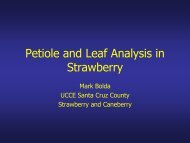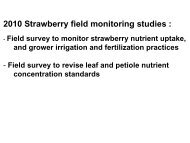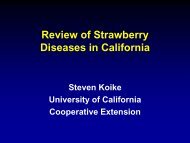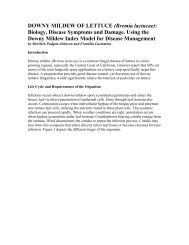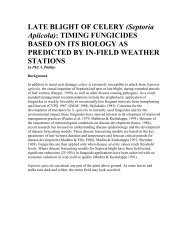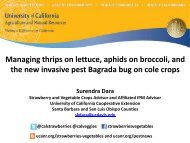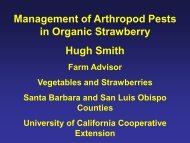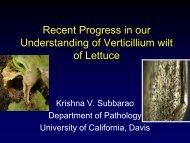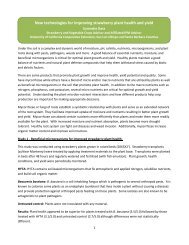Cantwell-Postharvest Update for leafy vegetables
Cantwell-Postharvest Update for leafy vegetables
Cantwell-Postharvest Update for leafy vegetables
Create successful ePaper yourself
Turn your PDF publications into a flip-book with our unique Google optimized e-Paper software.
<strong>Postharvest</strong> Handling <strong>Update</strong> <strong>for</strong> Leafy Vegetables1. Water relations and texture--broccoli2. Appearance and Nutritional Quality of Vegetables3. Fresh-cut Kale and importance of maturity4. Fresh-cut processing: Compare water-jet with blade cuttingSanta Maria Vegetable MeetingSept 17, 2013Marita <strong>Cantwell</strong>Dept. Plant Sciences, UC Davismicantwell@ucdavis.eduhttp://postharvest.ucdavis.edu
Water loss is CumulativeImpacts on QualityLoss of Salable WeightLoss Fresh AppearanceGlossShrivelPitting, sunken areasLoss of Texture, TurgidityChanges in Product PhysiologyCritical levels <strong>for</strong> many products5% shrivel, lose salability
Iceless BroccoliTemperature-yellowingMoisture loss-softeningTexture and Water loss6050% Firmness loss vs % Weight lossy = 7.228x; R 2 = 0.98% Firmness loss4030201000 1 2 3 4 5 6 7% Weight lossBroccoli held at 7.5CICELESS BROCCOLI Minimize delay from harvest to cooling Use plastic liners with holes to reduce water loss Keep it cold About 3-4% weight loss = soft head
Firmness Testing of BroccoliHead FirmnessStem FirmnessFirmness test of the heads using a50 mm aluminium flat cylinderprobe.Bending of the stems, using a 3point bending rig.
Broccoli (cv Ironman) harvested into per<strong>for</strong>atedbags and placed immediately in coolers with iceStorage: per<strong>for</strong>ated plastic bags insidewaxed carton boxes at 5°C (41°F)Fresh weight, % change86Change Fresh Weight (%)420-2-4-6-8-10-12Control30 min hydrate2 hour hydrate3% weight loss3% weight loss + 2 hour hydratePre- treatment 0 5 10 15 20Days at 5 o C
Head FirmnessStorage: per<strong>for</strong>ated plastic bags insidewaxed carton boxes at 5°C (41°F)120100Head firmness (N)806040200Control30 min hydrate2 hour hydrate3% weight loss3 % weight loss + 30 min hydratePre treatment 0 5 10 15 20Days at 5 o C
Stem FirmnessStorage: per<strong>for</strong>ated plastic bags insidewaxed carton boxes at 5°C (41°F)180160Stem firmness (N)140120100806040Control30 min hydrate2 hour hydrate3% weight loss3% weight loss + 30 min hydratePre treatment 0 5 10 15 20Days at 5 o C
Days to reach score 2Visual Quality and Shelf-life302826aa24bb22b20Control30 minhydrate2 hourhydrate3% weightloss3% w loss +30 minhydrate1 2 3 4 5
Broccoli Firmness and Water loss• 3% weight loss results in noticeable loss offirmness• Minimize delays to cool• Use plastic liners to reduce water loss and allowcooling (vacuum, <strong>for</strong>ced air)• Keep product cold• Sealed plastic packaging is not necessary tocontrol water loss• Sealed packaging will create MA which can bebeneficial in range of at 3-8% O2 and 5-12% CO2
Lucia Kaiser, Shermain Hardesty PIsWIC Project 2011<strong>Postharvest</strong> Quality of VegetablesObjectives– Determine whether visual cues <strong>for</strong> quality areindicative of good nutrient content– Evaluate a range of <strong>leafy</strong> and fruit <strong>vegetables</strong>– Evaluate a range of potential storage temperatures– Want to retain a minimum 80% of initial nutrientsArtichoke, Arugula, Asparagus, Bean, Broccoli,Cauliflower, Kale, Snap Pea, Spinach, Zucchini
WIC 2011<strong>Postharvest</strong> Quality of Vegetables• Purchased from wholesaler within 1-2 days of harvest• Held at 0, 10 or 20°C (32, 50 or 68°F) in unsealed bags• Evaluated after 0, 4, 8, 12 days; 3 replicates• Visual quality (9=excellent, 1=unusable; 6 is limit ofmarketability)• Decay/deterioration (1=none, 5=severe)• Vitamin C (total ascorbic acid activity, mg/100g FW)• Antioxidant activity (mg Trolox/100g FW)Determine time to retain 80% of original contentIs visual appearance (score 6) a good indicator of nutritive value?
Initial Composition of 10 VegetablesHigh phenolsGreenLeaf orstemImmatureFruit vegsWhite VegVegetableDry weight%Vitamin Cmg/100g FWAntioxidant Activitymg Trolox/100g FWArtichoke 17.2 95.4 347.0Arugula 10.2 211.0 160.7Broccoli 11.9 193.9 146.4Kale 11.6 179.6 157.0Spinach 9.8 99.5 169.5Asparagus 8.9 39.2 125.1Snap Pea 13.8 105.2 110.5Bean, green 10.6 55.1 19.1Zucchini 6.7 55.1 11.2Cauliflower 8.0 93.4 41.6LSD.05 0.5 12.2 18.4
9=excellent, 1=unusable9876543A. Visual qualityLSD.050°C (32°F)10°C (50°F)20°C (68°F)1=none, 5=severe5432B. Decay or deteriorationLSD.051=none, 5=severe5432C. YellowingLSD.050°C (32°F)10°C (50°F)20°C (68°F)2111mg/100g FW2602402202001801601401201008060D. Vitamin C E. Antioxidant activityLSD.050 2 4 6 8 10 12mg Trolox/100g FW18016014012010080604020LSD.050°C (32°F)10°C (50°F)20°C (68°F)0 2 4 6 8 10 120 2 4 6 8 10 12Days Arugula (a Brassica) is veryresponsive to storage temperature Low temperature retained VitaminC but antioxidants decreased at alltemperatures Arugula has high Vitamin C contentand high antioxidant activityDaysDays
ArugulaTemperatureDays to limit ofmarketabilityDays to 80%Vitamin CDays to 80%Antioxidant activity0°C (32°F) 8 >12 6.510°C (50°F) 3.5 6 3.520°C (68°F) 2 2 2CONCLUSIONS:Buying arugula based on visual appearance would ensure good nutritional quality.Antioxidant activity declines faster than Vitamin C content.
Shelf-life based on visual and nutrient aspectsDays that remainvisually marketable*Days that retain80% nutrient value**VEGETABLE 0°C(32°F)10°C(50°F)20°C(68°F)0°C(32°F)10°C(50°F)20°C(68°F)Artichoke 9 4 3 12 8 5Arugula 8 4 2 10 5 2Asparagus 14 9 5 12 8 3Bean, green 14 8 5 12 12 10Broccoli 14 9 4 10 7 4Cauliflower 8 5 3 12 10 7Kale 14 8 4 12 10 6Snap Pea 14 8 5 14 14 10Spinach 14 7 3 14 10 4Zucchini 14 12 9 12 12 10AVERAGE 12.3 7.4 4.3 12.0 9.6 6.1* Number of days to reach a score of 6 from a 9 to 1 scale, where 9=excellent, 8=very good, 7=good, 6=moderately good and marketable, 5=fair but unmarketable, 4=low, 3=poor, 2=almost unusable and 1=unusable**Number of days to retain 80% Vitamin C and antioxidant activity
Is visual appearance a good indicatorof nutritive value? Generally YES!VegetableArtichokeArugulaAsparagusBean, greenBroccoliCauliflowerKaleSnap PeaSpinachZucchiniConclusionYesYesNoYesPartiallyyesYesYesYesYesUsed 80% retention of Vitamin C and Antioxidant Activity at the limit ofmarketability as criteria to answer the question
Marketability evaluation - Intact leaves10How important is leafmaturity <strong>for</strong> quality andshelf-life of kale productsOverall visual quality8642Day vs Stage 1Day vs Stage 200 2 4 6 8 10 12 14Time (Days at 7.5°C)
0°C (32°F) 5°C (41°F) 10°C (50°F)8d12d16d
Fresh-cut KaleImportance of Leaf Maturity1. Determine the impact of maturity onper<strong>for</strong>mance of kale leaves in fresh-cut <strong>for</strong>matat two storage temperatures2. Determine relationships between compositionanalyses and indicators of the senescenceprocess20
Materials and methods• Kale cv. Lacinato• Leaves were harvested at threematurity stages based on:– Length (petiole included)– Width (Point of maximum leafexpansion)• Unlike other cultivars, color isnot a maturity criteriaCriteria Immature Mature OvermatureLength 35 cmWidth 5 cm
Materials and methods• Preparation at 7.5°C (45°F)- Trim, cut 1 cm strips across midrib- Wash chlorinated water (50 ppm NaOCl)- Drain, centrifuge- Package unsealed plastic PE bas on covered tray at0.5 and 5°C (33 and 41°F) <strong>for</strong> up to 42 and 28 days• Evaluations- Marketability assessment (visual quality, defects)- Composition (chlorophyll, carotenoids, ammonia,malondialdehyde)
Criticaldifferences inmaturity
Marketability evaluations0.5°C (33°F)5°C (41°F)Yellowing1=None 5=Severe543ImmatureMatureOvermatureImmatureMatureOvermature28 days 14 days543Decay/Deterioration1=None 5=Severe21054321ImmatureMatureOvermatureImmatureMatureOvermature2▪ Important differences1between 0.5 and 5°C054▪ Overmature leaves3had the higher defect2scores1Discoloration1=None 5=Severe0543ImmatureMatureOvermatureImmatureMatureOvermature0543221100 14 28 42Storage time (Days)0 14 21 28Storage time (Days)024
Ammonia0°C5°C0.80.8Ammonia(mg/g FW)0.60.4ImmatureMatureOvermatureImmatureMatureOvermature0.60.40.20.20.00.00 14 28 42Storage time (Days)0 14 21 28Storage time (Days)• Ammonia is an indicator of senescence• Increases as nitrogen compounds are metabolized• Significant differences due to temperature• 0°C: No significant differences between maturity stages• 5°C: Significant increases after day 14. Differences between maturitystages: higher in overmature leaves. Lower in immature leaves.25
Ammonia and Leafy & Floral Tissues• Ammonia can be useful to monitor stressfulCA/MA as well as senescence• Consequences of increases in ammonia– Relate to sensory and other quality attributes– Relate to physiology and freshness of <strong>leafy</strong> greens• Tissue ammonia correlated to ammonia inpackage atmospheres?– Use as a rapid indicator of stress and/or temperatureabuse <strong>for</strong> <strong>leafy</strong> vegs (broccoli, spinach, asparagus)
Water-jet Cutting Project• Assessment of per<strong>for</strong>mance• 6 products <strong>for</strong> fresh-cut– Lettuces, celery, cabbage, broccoli• 2 types of orifices (sharp, fuzzy)• 3 pressures (35, 45, 55K PSI)• 3 traverse speeds• Cut surface appearance• Shelf-life and quality commercially cutproduct and waterjet cut productsAB
Commercial blade cutWaterjet cut (sharp nozzle)6 days 5°C; no modified atmosphere2012
Commercial blade cutWaterjet cut (sharp nozzle)8 days 5°C; packaged,no modified atmosphere2012
Sharp vs Dull knife; 3 days air 5°C• Sharp vs dull effect on product quality• Guidelines <strong>for</strong> knife sharpness?• Sharp knives make a difference but how toquantify the effect and blade quality
Used or Dull bladeNew or sharp blade Fuzzy nozzle Sharp nozzlePackaged, no MA, 18 days at 2.5°C (36°F)Test#1 FrEx 2013
Used and sharpened bladesSharp new bladesSharp nozzle(slow speed, high pressure)Package, no MA; 8 days at 2.5C in airTest #2 FrEx 2013
• Overall appearance• Decay• Discoloration (pinking or browning)• Drying or whitening cut edges Romaine Lettuce9.0 A. Visual Quality9=excellent, 8=very good, 7=good8.88.68.48.28.07.87.67.4LSD.05T1= used knivesT2= new knivesT3= fuzzy nozzleT4= sharp nozzle7.20 2 4 6 8 10 12 14 16 18Days at 2.5CData average of 50 pieces per rep per evaluation per treatment, evaluating at both cut ends; 4 reps.Test#1 FrEx 2013
Romaine Lettuce2.8 B. Discoloration1=none, 2=slight, 3=moderate2.62.42.22.01.81.61.41.2LSD.05T1= used knivesT2= new knivesT3= fuzzy nozzleT4= sharp nozzle1.00.80 2 4 6 8 10 12 14 16 18Days at 2.5CData average of 50 pieces per rep per evaluation per treatment, evaluating at both cut ends; 4 reps.Test#1 FrEx 2013
Waterjet Cutting• Quality of some fresh-cut <strong>vegetables</strong> is betterwith waterjet cutting than blade cutting(celery, romaine lettuce)• No differences in microbial (TPC) betweenwaterjet and blade cutting in romaine• Nozzle type is key component of waterjettechnology; pressue and speed play minorroles
http://postharvest.ucdavis.eduProduce Facts• Harvest indices• Quality indices• Temperature and RH• Freezing point/damage• Respiration rates• Ethylene production• Effects of ethylene• Effects of modifiedatmospheres• Physiological disorders• <strong>Postharvest</strong> diseases• Mechanical injury• Photos140FruitsVegetablesFlowersFree, content-rich website averages over 3 million views annually,And encompasses more than 640 pages and 1750 pdf documents.
http://postharvest.ucdavis.eduUpcoming Workshops at UC Davis• Fresh-cut Products: Maintaining Quality and Safety. Workshop, 18 th annual,September 24-26, 2013.• Produce Safety: A Science based Framework Workshop. 1 st annual. November 5-7, 2013. This interactive workshop will improve awareness and appreciation of thetools used <strong>for</strong> effective hazard analysis and quantitative risk assessment.• Methods of Measuring Fruit and Vegetable Quality: Color, Flavor, Texture.January 22, 2014.• Fruit Ripening and Retail handling Workshop. March 25-26, 2014. 20th Annual.• <strong>Postharvest</strong> Technology Short Course. 36 th annual. June 16-27, 2014. This coursewill be held June 16-20, 2014 at UC Davis with an optional Field Tour June 23-27.• Fresh-cut Products: Maintaining Quality and Safety. Workshop, 19 th annual,September 23-25, 2014.• Produce Safety: A Science based Framework Workshop. 2nd annual. November4-6, 2014.



